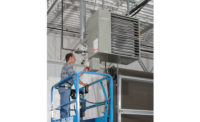Proper equipment sizing is based on the interior of homes losing heat during cold weather and gaining heat during warm weather. Consider several key pieces of information (such as the type of insulation and the total surface area of the windows or glass doors) into a heat loss/heat gain evaluation called a design load calculation.

After the load calculations are completed, ducts, supply registers, and return grilles can be sized and selected using professional guidelines in ACCA's Manual D or by a comparable industry-accepted method.
Oversized equipment can cause reduced comfort and excessive "air" noise as the oversized unit forces air through the duct system more quickly. Oversizing will also shorten the life of the equipment by causing it to cycle on and off more frequently than a properly sized unit.
Undersized equipment with airflow that is too low can cause distribution efficiency drops and accelerated wear on system components, leading to earlier failure.
1. Make sure the unit is installed in an accessible area for easy maintenance.
2. Allow plenty of room for free airflow on all sides of the equipment.
3. Verify that equipment placement is in accordance with the manufacturer's installation instructions and local codes.
Test your customer's duct system to identify leaks and fix them with quality duct sealant. Duct sealing should be done by using mastic, metal-backed tape, or aerosol-based sealing. Ensure that the duct system is not only sealed, but within conditioned space. If the ducts must be in unconditioned space (basement, attic, crawlspace), they should be insulated.
In some instances, you may find it necessary to replace or add ducts. If there are insufficient supply registers or return air grilles in your customer's home, it may be necessary to install additional ductwork to accommodate the need for registers or grilles. Sizing for the system will provide the guidelines necessary to determine if additional ductwork is required to supply optimal comfort and should be based on analysis using Manual D.
If airflow is too high, duct leakage increases and the temperature at the register is not sufficient for optimal home comfort. If airflow is too low, distribution efficiency drops, and it accelerates the wear on system components leading to premature failure.
Reprinted and excerpted from the Energy Star Web site, HVAC Contractors page, "Offer a quality installation to increase efficiency." For more information, visit http://energystar.gov.
Publication date: 02/07/2005





